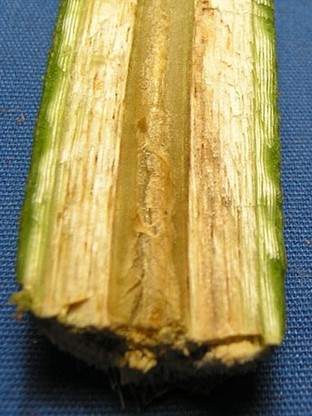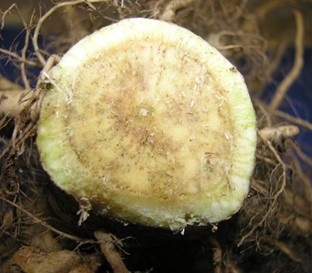Disease Notes
Contact
Plant Diagnostician
Phone: (479) 575-2727
Email: ssmith@uada.edu
Jason Pavel
Diagnostician
Phone: (479) 575-7257
Email: jpavel@uada.edu
University of Arkansas System Division of Agriculture
Cralley Warren Building
Room 16
2601 N. Young Ave.
Fayetteville, AR 72704
Okra – Wilt
by Sherrie Smith and Jason Pavel

Okra Verticillium Wilt – Verticillium dahliae
Photo by Sherrie Smith, University of Arkansas Cooperative Extension
Those who like okra can’t get enough of this favorite southern vegetable. Okra grows best on sandy, well-drained loamy soils with a ph of 6.5 -7.0. It has minor disease problems when adequate growing conditions are provided. However, okra is susceptible to wilt diseases caused by verticillium or fusarium species.
What are the signs of wilt diseases in okra?
Symptoms are yellowing and wilting of leaves and eventual collapse of the plant. When the stems are cut open, brown streaking and flecking can be seen in the vascular bundle. It is impossible to tell which pathogen is responsible for the wilting with certainty without culturing tissue in the lab. Verticillium is more common during cooler weather, and the streaking is sometimes darker brown to black in color.
What are control recommendations for okra wilt diseases?
There is no real resistance to these diseases in okra. The only control measures are to clean up all plant debris every season, and to practice crop rotation as rotation with nonsusceptible grasses and grains may be of some value.

Okra Verticillium Wilt – Verticillium dahliae
Photo by Sherrie Smith, University of Arkansas Cooperative Extension
Take Aways
- Practice crop rotation with non- hosts such as grasses.
- Clean up all plant debris each season.
This work is supported by the Crop Protection and Pest Management Program [grant no. 2017-70006- 27279/project accession no. 1013890] from the USDA National Institute of Food and Agriculture.